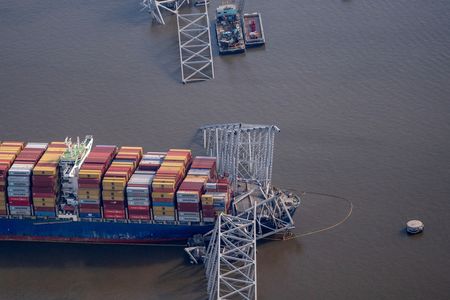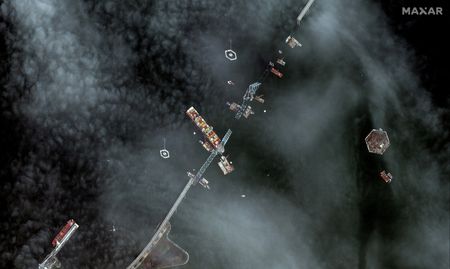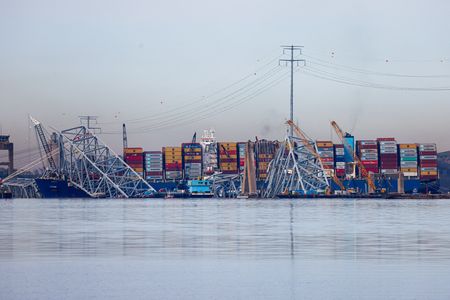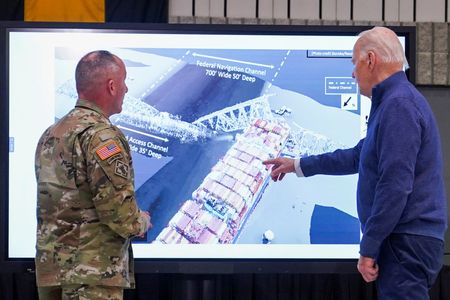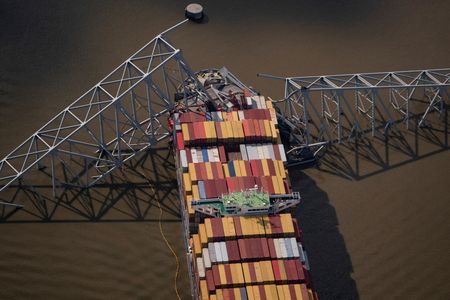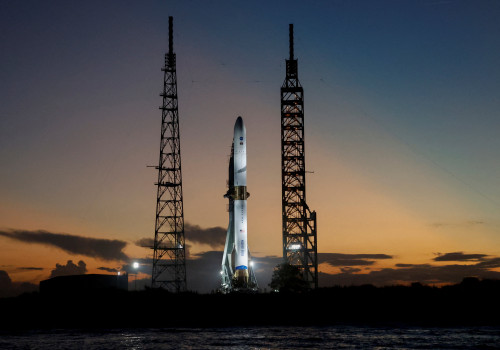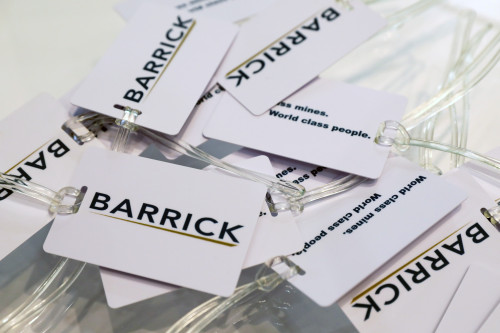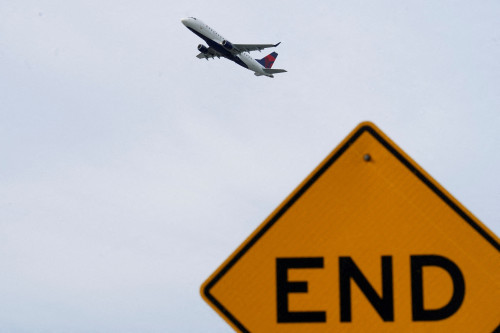By Lisa Shumaker
(Reuters) – The FBI has opened a federal criminal investigation into the deadly collapse of Baltimore’s Francis Scott Key Bridge as work continues to clear the wreckage after last month’s collapse.
In March, a container ship crashed into one of the bridge’s support pillars, sending the span crashing into Baltimore Harbor and killing six construction workers who were thrown into the water.
Replacing the bridge will likely take years, but authorities have opened two temporary channels to allow some shallow-draft vessels, such as barges and tugboats, to move around the stricken cargo ship.
President Joe Biden visited Baltimore and pledged federal help to rebuild the span, an idea some Republican lawmakers have resisted.
WHAT IS THE DEATH TOLL IN THE BRIDGE COLLAPSE?
The six victims of the bridge collapse were all immigrants from Mexico and Central America who were fixing potholes on the road surface of the bridge when it collapsed early on March 26.
Dive teams have recovered three bodies so far:
* Maynor Yasir Suazo-Sandoval, 38, of Honduras
* Alejandro Hernandez Fuentes, 35, of Baltimore, originally from Mexico
* Dorlian Castillo, 26, of nearby Dundalk, originally from Guatemala.
Three other bodies remain trapped beneath the underwater debris in the 50-foot-deep (15 meter-deep) waters. They are Jose Lopez from Guatemala, Miguel Luna from El Salvador, and another whose name has not been released.
Two other workers were rescued from the channel shortly after the collapse, one of whom was hospitalized.
The ship’s pilot and crew had reported a loss of power before impact and dropped anchor to slow the vessel, giving authorities barely enough time to halt traffic on the bridge, which likely prevented greater loss of life.
WHEN DID THE BALTIMORE BRIDGE COLLAPSE?
Shortly after 1 a.m. EDT (0500 GMT) on March 26, the container ship Dali was heading out of Baltimore Harbor along the Patapsco River on its way to Sri Lanka. At 1:24 a.m. (0524 GMT), the ship experienced a power failure and all its lights went out.
Three minutes later, at 1:27 a.m. (0527 GMT), the vessel struck a pylon of the bridge, and nearly the entire structure of the span crumbled into the water in seconds.
The disaster may be the worst U.S. bridge collapse since 2007, when a design error caused the Interstate 35W bridge in Minneapolis to plunge into the Mississippi River, killing 13 people.
WHAT FACTORS PLAYED A ROLE IN THE BRIDGE COLLAPSE?
Bridges such as the one in Baltimore are classified as “fracture critical” by the federal government – meaning that if one component or “member” of its primary structural frame fails, all or most of the span will collapse. There are more than 16,800 such bridges in the U.S., according to the Federal Highway Administration.
The head of the National Transportation Safety Board said fracture critical spans lack structural engineering redundancies that are common to newer bridges, making them less vulnerable to catastrophic collapse.
The Key Bridge opened in 1977 – three years before a similar vessel collision into the Sunshine Skyway Bridge in Tampa Bay, Florida, killed 35 people, and prompted bridge designers to provide better protections for foundation piers.
HOW MUCH WILL THE BALTIMORE BRIDGE COST TO REPLACE?
Federal officials have told Maryland lawmakers the final cost of rebuilding the bridge could soar to at least $2 billion.
To fully replace the bridge, Congress would need to approve funding, and there are growing signs of friction about using federal dollars to fund the bridge’s reconstruction.
Biden has said he wants the federal government to pay to rebuild the bridge. The Transportation Department on March 28 awarded $60 million in “quick release” emergency funds to aid in clearing debris and begin rebuilding.
After the 2007 bridge collapse in Minnesota, Congress allocated $250 million.
Insurers could face billions of dollars in claims, analysts said, with one putting the cost as high as $4 billion, which would make the tragedy a record shipping insurance loss.
HOW LONG WILL IT TAKE TO REBUILD THE BALTIMORE BRIDGE?
Rebuilding could be a lengthy process and will depend on whether any of the remaining structure can be salvaged. It took five years to build the original bridge from 1972-1977.
WHEN WILL THE BALTIMORE PORT REOPEN?
The U.S. Army Corps of Engineers said it expects to open a new channel for commercial shipping by the end of April and restore port access to full capacity by the end of May.
Authorities opened two temporary channels to allow essential vessels to go around the stuck vessel. The channels are 11 feet (3.4 meters) and 14 feet (4.3 meters) deep. Major cargo ships need a depth of at least 35 feet (10.7 meters).
Closing the Port of Baltimore for just one month would cost Maryland $28 million in lost business, according to economic analysis firm IMPLAN.
WHAT TO KNOW ABOUT THE CARGO SHIP DALI AND ITS STRANDED CREW
The Dali was leaving Baltimore en route to Colombo, Sri Lanka, with a crew of 21 plus two pilots on board. All were safe and accounted for.
The ship’s length is 948 feet (289 meters) – as long as three football fields – and was stacked high with containers. Safety investigators recovered the ship’s “black box” recorder, which provides data for the vessel’s position, speed, heading, radar, bridge audio, and radio communications, as well as alarms.
The same ship was involved in an incident in the port of Antwerp, Belgium, in 2016, when it hit a quay as it tried to exit the North Sea container terminal.
An inspection in June 2023 carried out in San Antonio, Chile, found the vessel had propulsion and auxiliary machinery deficiencies, according to data on the public Equasis website, which provides information on ships.
According to Singapore’s Maritime and Port Authority, the vessel passed foreign-port inspections in June and September 2023.
The registered owner of the Singapore-flagged ship is Grace Ocean Pte Ltd, LSEG data show. Synergy Marine Group managed the ship, and Maersk chartered the vessel.
WHAT DO WE KNOW ABOUT THE BRIDGE THAT COLLAPSED?
The fallen bridge was one of three highway routes traversing Baltimore Harbor — the two others are tunnels beneath the harbor — and handled 31,000 cars per day, or 11.3 million vehicles a year.
The steel structure was four lanes wide and rose 185 feet (56 meters) above the river. It opened in 1977 and crosses the mouth of the Patapsco River.
The bridge is named for Francis Scott Key, who wrote the words to the U.S. national anthem, the “Star-Spangled Banner,” in 1814 after witnessing the British bombardment of the U.S. garrison at nearby Fort McHenry from Baltimore Harbor.
HOW WILL THE BRIDGE COLLAPSE AFFECT THE BALTIMORE PORT?
Shipping traffic was suspended at the port, the 17th largest in the country, idling some 15,000 workers whose jobs directly depend on port operations.
The flow of container freight to Baltimore can likely be redistributed to bigger ports. However, there could be major disruptions in shipments of cars, coal and sugar.
Baltimore is the busiest U.S. port for shipments of cars and light trucks, handling at least 750,000 vehicles in 2023, according to data from the Maryland Port Administration.
In 2023, the port was the second busiest for coal exports.
It is also the largest U.S. port by volume for handling farm and construction machinery, as well as agricultural products such as sugar and salt.
(Writing by Lisa Shumaker; Editing by Daniel Wallis, Bill Berkrot and Jonathan Oatis)

